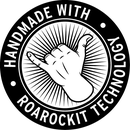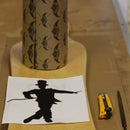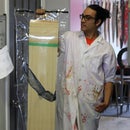Introduction: How to Teach Skateboard Building in Schools
The Roarockit deck building system has been working successfully in schools around the world since 2000!
Skateboard building can be used to teach students math, science, woodworking, art & design, business, and many more subjects. We recommend students aged 10 and up for the project.
While skateboard building is not a 'traditional' method of teaching, instructors who have used the program have reported many benefits in their classrooms, including:
- increase in attendance levels
- students are focused, attentive and apply themselves to complete their decks
- can work as an incentive for both 'under' and 'over-achieving' students
- teamwork and mentoring scenarios occur naturally during the build process
- students gain experience working with their hands
- the program can be applied to a wide range of STEM and STEAM subjects including Art & Design, Mathematics, Construction Technology, Business and Entrepreneurship, Physical and Environmental Sciences and more
- students relate well to skateboards and its counter-culture aspects
- great opportunity to involve their community through fundraisers, art galleries, open-houses, etc.
Another great part about Roarockit skateboard building is that it doesn't require the use of power tools and can be done in any classroom, or even outdoors! The Thin Air Press is considered to be the 'greenest' method of pressing skateboards in the world (it's all hand powered!), and there are no harmful glues, paints or coatings required.
Important: This lesson will be based on teaching skateboard building using the Roarockit method of building skateboards.
Please note that vacuum bagging has been used for many years in different industries, and there are other options on the market. This tutorial is specific to the Roarockit Skateboard Company's Thin Air Press vacuum bag system.
Supplies
- Roarockit Teacher's Kits
- 220, 150, and 100 grit sandpaper sheets
- 80 grit (cloth) belt sandpaper, cut lengthwise into 1" strips
- Selection of clamps or benches with vises
- Paints, markers, and other art supplies
- Liquid polyurethane (or finish of choice)
- Work aprons
Step 1: Learning Outcomes
Building skateboard decks in class provides the opportunity to incorporate many lessons, some of which we've outlined below. Project-based learning is a great opportunity for students to learn practical lessons based on real-world concepts. These are just some examples of the lessons you can teach using skateboard building, the possibilities are endless!
- Math, Science and the Physics of Vacuum Pressure:
Roarockit Skateboards are made using atmospheric pressure to press thin pieces of wood over a mold into shape. This is a great opportunity to include your own relevant experiments about the physics and practical uses of vacuum.
- Woodworking without Power Tools:
Maple veneer (especially Canadian-grown) is known to be the best in the world for skateboards and is what is included in Roarockit deck kits. Learning about grain direction, strength of wood, preparing, gluing and finishing are just a few of the lessons possible. This is also an opportunity to talk about the properties of wood compared to other materials and why Canadian maple is the best material for a skateboard.
- Environment:
Skateboards are green in many ways including: transportation, locally acquired and non-toxic materials, hand-building, and their small carbon footprint.
- Art & Design:
This section is generally the area that can be expanded the most and can fill an entire semester. You can include lessons on the history of deck art, the elements & principles of design, conceptualizing your design, application, intellectual property, logos, creating a personal brand, and many more topics. See step 4 for more information on this topic.
- Business and Entrepreneurship:
The best part about building skateboards using the Roarockit method is that most of the materials and tools are reusable! Create an ongoing program by building multiple decks with the reusable tools and Thin Air Press Kits. This is an opportunity to create a company store, manage the funds, and find sponsors - giving students a taste of how a real business functions.
- Leadership, Teamwork & Mentorship:
Once students have the skills to build a skateboard deck, they can assist or teach others through mentorship, outreach, summer camp and after-school programs. Senior students can use their experience to help mentor other students throughout the process.
See more information on how you can incorporate these lessons into the project at http://www.thinairpress.com/curriculums.
Step 2: Real World Program Success
Our Educational Consultant, Craig Morrison is a high school teacher in Toronto, Canada who founded and leads a highly successful business-based program. The full-time curriculum is focused on skateboard deck building and street art.
Teacher Lauren Hortie works with Craig Morrison to offer their students a curriculum to allow them to earn their high school compulsory and elective credits over 2 semesters. Students gain entrepreneurial experience by creating their own brand and running a skateboard business and professional design studio.
Students have proven to respond incredibly well to this ground-breaking Toronto District School Board program. The high graduation, attendance and literacy rates show that this 10 year-old program is truly a recipe for Student Success!
We invite you to visit oasisskateboardfactory.blogspot.com for a progress report on his exciting programs.
Read more teacher success stories using the Roarockit method on our blog.
Step 3: How to Build a Skateboard
Teacher’s Kits are the very best way to become familiar with the deck building process, available in many different board shapes for any class size.
Using the Roarockit Skateboard Company's Thin Air Press technology, this is a quick look at how to laminate a skateboard using our pre-shaped veneers and molds.
- Glue the veneers
- Place them on top of the foam mold
- Put them both into the vacuum bag
- Evacuate the air using the hand pump
- Let dry for 8 hours
- Remove the board from the bag
- Scrape the edges flush
- Round edges with scrapers and sandpaper
- Sand edges and faces of board
- Apply art/graphics (see next step for more information)
- Apply a protective coating to the board
Please view the video for a more in-depth explanation of the process of building a skateboard in a 5 day class format, or view our other Instructables for more tutorials on how to laminate veneers using our Thin Air Press bag.
Step 4: Art and Skateboards
This is the most flexible and expandable part of using skateboard deck building in a curriculum. From simply designing and painting a finished and sanded deck, to an in-depth exploration of its history, skateboard art provides a rich resource for learning and discussion.
Art sessions can start even before the decks are built, and carry on past when they are finished and ready to hang in an art exhibition!
Some examples of the possibilities of topics that can be learned through the art and design of a skateboard deck are:
- Elements and Principles of Design
- Logo design
- Creating a personal brand
- Copyright and intellectual property rights of art
- Social Messaging
- History of skateboard art
- Current and historical graffiti and street art
and many more!
Check out http://www.thinairpress.com/art-design to see more information about how your students can learn through skateboard building.
Step 5: Taking It Further
One of the great things about building skateboards in class is that it allows you to easily take the learning opportunities beyond the classroom!
Funds raised from selling boards can be used to help fund the program materials year after year. Students can find a customer, design a board for them, and meet their approval and delivery deadline.
Another option is to host an art show or auction. Students must plan the event, including marketing with media advertising (posters, buttons, stickers, flyers, etc.), set up the event, engage a location and have students learn how to display skateboard final art decks with backdrops and support material.
After completing the skateboard building program, students have gone on to open their own businesses based on what they have learned through the experience. The lessons learned from building skateboards in class will be carried by students for the rest of their lives.
For more information, please visit our website at roarockit.com
We hope this Instructable inspires you to build skateboards with your students!






